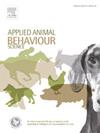Behavioral or nutritional drive: which motivation affects rates of food grinding in CD1 mice?
IF 2.2
2区 农林科学
Q1 AGRICULTURE, DAIRY & ANIMAL SCIENCE
引用次数: 0
Abstract
Wire mouse feeders used in laboratory mouse cages typically hold enough food to feed 5 mice for two weeks. However, some mice gnaw the food provided into powder, which they do not ingest. The ground-up food fills the cage, resulting in miscalculations of food consumption, welfare issues with blocked water valves and frequent cage handling, more frequent cage changes, and economic issues of food wastage. There is a dearth of studies attempting to understand the causes behind food grinding behavior. This study, following on from previous work, sought to determine if the motivations behind food grinding were related to a mouse’s innate behavioral drive to gnaw or rather a nutritional drive to seek out macronutrient components in the feed. We replicated previous results where high fat treatments (either shell-on sunflower seeds or a diet with macronutrient equivalence to a sunflower kernel), but not the method of delivery of the higher-fat treatments, decreased the amount of ground food produced per cage. Further, the composition of the gnawed food changed over the course of the study, generally with protein increasing and fat decreasing in the gnawed feed, especially after treatments were removed. We also replicated previous results which found differences in the composition of the gnawed feed in comparison to the original diet. These results support the hypothesis that food grinding behavior is driven by a nutritional motivation, not a behavioral one.
求助全文
约1分钟内获得全文
求助全文
来源期刊

Applied Animal Behaviour Science
农林科学-行为科学
CiteScore
4.40
自引率
21.70%
发文量
191
审稿时长
18.1 weeks
期刊介绍:
This journal publishes relevant information on the behaviour of domesticated and utilized animals.
Topics covered include:
-Behaviour of farm, zoo and laboratory animals in relation to animal management and welfare
-Behaviour of companion animals in relation to behavioural problems, for example, in relation to the training of dogs for different purposes, in relation to behavioural problems
-Studies of the behaviour of wild animals when these studies are relevant from an applied perspective, for example in relation to wildlife management, pest management or nature conservation
-Methodological studies within relevant fields
The principal subjects are farm, companion and laboratory animals, including, of course, poultry. The journal also deals with the following animal subjects:
-Those involved in any farming system, e.g. deer, rabbits and fur-bearing animals
-Those in ANY form of confinement, e.g. zoos, safari parks and other forms of display
-Feral animals, and any animal species which impinge on farming operations, e.g. as causes of loss or damage
-Species used for hunting, recreation etc. may also be considered as acceptable subjects in some instances
-Laboratory animals, if the material relates to their behavioural requirements
 求助内容:
求助内容: 应助结果提醒方式:
应助结果提醒方式:


